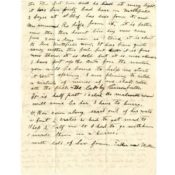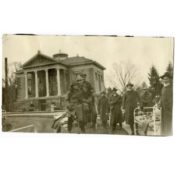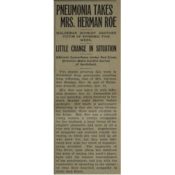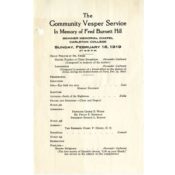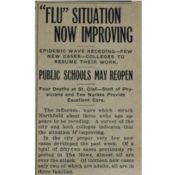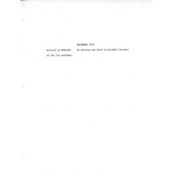
By Stephanie Hess, Northfield-Rice County Digital History Collection, January 2018
The influenza virus that arrived in Northfield in early November 1918 was unlike anything anyone had ever seen. It spread rapidly, targeted young adults, and killed in high numbers. It also caused significantly stronger symptoms than ordinary seasonal influenza. Newspapers in Spain were among the first to report on this new disease, so it became known as the "Spanish Influenza." But the disease was a worldwide pandemic.
The first cases of influenza occurred in Minnesota during the last week of September at military camps. By September 30, 1918, both Fort Snelling and the Dunwoody Naval Institute in Minneapolis were under quarantine. The virus spread to civilians within a week, however, and then it started to travel south towards Northfield.
Northfield leaders were aware that influenza was spreading throughout the country and state and took steps to try to prevent the infection of the town. On October 11, 1918, the city’s Board of Health issued quarantine regulations to any place where large groups of people would meet. Area churches, the public schools, the Grand Theater, pool halls, and the Community Club closed indefinitely. Despite these measures, local physician Dr. W. Wilson noted his first Northfield case of influenza on November 3, 1918. The disease was finally here.
By November 14, influenza cases in Northfield numbered 40 at Carleton College, 29 at St. Olaf College, and 41 in the city for a total of 110. Most of these cases were considered mild, and so far, influenza had caused only one death—that of Minnie Marko, a 17-year-old local girl.
In response, city health officer Dr. J. G. Phillips and Mayor A. O. Netland mobilized town and college leadership to control the spread of both infection and fear. They organized a group of school teachers to conduct daily house-to-house surveys to get an accurate count of victims of the disease. If any people showed influenza symptoms, they had to remain at home and put a sign in their window.
Northfield schools superintendent M.P. Forbes organized the local Red Cross Committee's nursing response in town. His volunteers distributed gauze masks and provided food to affected families. Public gatherings were discouraged overall, church services were canceled during the holidays, and the public schools remained closed until after Christmas break.
During this time, both St. Olaf and Carleton Colleges had companies of the U.S. Army’s Student Army Training Corps (S.A.T.C.) on campus. Leaders of the S.A.T.C. created quarantine orders for their student-soldiers, but they could not entirely prevent infection. Carleton’s S.A.T.C. reported that about 70 students with influenza symptoms were removed to the gymnasium to separate them from those not affected by the disease.
At St. Olaf College, about 80 to 90 cases developed almost immediately during the first week of November among members of the S.A.T.C. Three doctors, 11 nurses, 75 S.A.T.C. orderlies, and 2 Home Economics teachers cared for the sick patients. Several St. Olaf women also fell sick after caring for the student-soldiers. Although most of the students on campus recovered, St. Olaf president Lars W. Boe terminated the semester early on December 7, 1918, to prevent a second wave of infection and sent the students home.
Despite these precautions, several Northfielders did die from the disease—many at the prime of their lives. Anna (Kirkeberg) Roe, a St. Olaf College music teacher and the wife of Northfield News editor Herman Roe, died on November 18, 1918, after a week of illness. She was only 31 years old and left behind three young children. St. Olaf College also lost four freshmen S.A.T.C. students between November 21 and 25, 1918: Waldemar Schmidt, Oscar Mohagen, Peter Reinertson, and Joseph Tandberg.
On January 29, 1919, most people assumed the worst of the influenza had passed. They were shocked by the news that one of Northfield’s community leaders and Carleton College professor Fred Burnett Hill died from the disease. Like other victims, his influenza had worsened and pneumonia developed in his lungs.
Still, as quickly as it came, by late February the epidemic had left the Northfield area. Isolated cases continued to appear in Rice County until the 1920s but not to the extent it did in 1918.
While it is impossible to get an accurate count, many experts estimate that influenza killed close to 10,000 Minnesotans, and nearly 675,000 Americans. They believe influenza caused more than half of the total U.S. Army's World War I deaths and killed over 50 million people worldwide. The influenza pandemic spread fear, paranoia, and helplessness in addition to a dangerously contagious disease. But it also led to a rise in volunteerism, civic-mindedness, and community service throughout the Northfield region.
Primary Sources
Discussion Questions
When you look at the individual items in the Northfield-Rice County Digital History Collection, use the zoom-in tool to view details in the images or more easily read the documents. Use the tab labeled “TEXT” to read full transcriptions of the documents.
- Imagine you were living in Northfield in 1918. How would you feel when you read about this terrible new disease that was coming your way? What would you do?
- Would you willingly follow the city’s regulations on your activities to prevent infection, or would you resist them? Why?
- Think about how the people of Northfield received news about the disease – through newspaper reports and also letters from friends and family. How are these sources of news similar, and also different? Which source would you trust more at the time, or now?
- Looking at the church documents, what do they tell us about how the epidemic affected community life and normal activities?
- Why do you think people called the disease the “Spanish Influenza,” when it was technically everywhere in the world?
- The influenza pandemic killed more young adults than regular influenza does. What effect would this death toll have on a community, especially on its future generations?
- Why do you think the S.A.T.C. students look like they’re having a good time in the middle of an epidemic? Describe some ways people have coped during times of stress.
- During times of war, people often let the government have more power over their lives than they would during times of peace – including checking in on them daily for signs of influenza infection. Explain why that is.
- Describe the ways the members of the community mourned those they cared about – siblings, daughters, leaders of the community, etc. What steps did they take to memorialize their dead? How is that similar to or different than we do it today?
- Imagine you are in charge of informing the public about a similar disease today. How would you communicate the facts so people know what to do without causing them to panic? Would you provide all the details or keep some known only to a few? Why?
Classroom Activity
Imagine that a new disease is spreading across the country, and it is only a matter of time before it reaches your community. What steps do you take to prevent it, or to reduce its effect? How do you mobilize groups and/or individuals within your communities? Think about the kind of expertise you will need to rely on to fight the disease and keep the community moving along as well as possible during the crisis. Create a flow chart identifying those groups that specifies their responsibilities.
Additional Resources for Research
Ayres, Leonard P., Col. The War With Germany: A Statistical Summary. Washington: Government Printing Office, 1919. Accessed online 12 January 2018.
Barry, John M. The Great Influenza: The Epic Story of the Deadliest Plague in History. New York: Viking, 2004.
Barry, John M. “How the Horrific 1918 Flu Spread Across America,” in Smithsonian Magazine, November 2017. Accessed online 11 January 2018.
Benshoof, Sam. “Celebration of Armistice in 1918 tempered by influenza quarantine,” in The Carletonian, 2008 Fall Issue 7 (November 7, 2008). Accessed online 25 January 2018.
Byerly, Carol R. “The U.S. Military and the Influenza Pandemic of 1918-1919,” in Public Health Reports, 125 (suppl 3) 2010, 82-91. Accessed online 12 January 2018.
“The Deadly Virus: The Influenza Epidemic of 1918” online exhibit. National Archives and Records Administration. Web. Accessed online 31 January 2018.
Hanson, Dr. Alice M. “The ‘Spanish’ Influenza Epidemic of 1918 in Northfield, MN,” in The Scriver Scribbler, a Northfield Historical Society quarterly publication, Fall 2008. Original manuscript in NHS archives dated 2 Feb 2003. Accessed online 12 January 2018.
Homer Mason file at St. Olaf College Archives, accession number 3458.
Hvistendahl, Susan. “Carleton’s Beneficent Fred B. and Deborah Sayles Hill,” a Historic Happenings article in The Entertainment Guide, Northfield, Minnesota. February 2015, pp. 31-35.
Khaki & Blue Algol yearbook. Carleton College, 1919-1920. Accessed online 31 January 2018.
Laine, Mary. “Influenza Epidemic in Minnesota, 1918.” MNopedia, Minnesota Historical Society. Web (accessed February 13, 2019).
Northfield News issues, 1918-1919. Available online through the Minnesota Historical Society’s Digital Newspaper Hub [filter by city and year]. Relevant articles include:
- “Precautions Taken are to Forestall Epidemic,” Oct. 11, 1918, p. 1.
- “It’s Up to You to Fight Flu,” and “City Assumes Relief Campaign… Quarantine Rules Endorsed,” Oct. 25, 1918, p. 1 – note, most of the headlines of that issue relate to the devastating fires up in northern Minnesota, not the flu.
- “‘Flu’ Spreads; Quarantine On,” and “‘Flu’ Survey Made,” Nov. 15, 1918, p. 1.
- “Pneumonia Takes Mrs. Herman Roe,” Nov. 22, 1918, p. 1 and continued on p. 4.
- “Obey the Ban”, Nov. 22, 1918, p. 4.
- “‘Flu’ Situation Now Improving,” Nov. 29, 1918, p. 1 and continued on p. 4.
- “Early Shopping Again Possible,” Dec. 6, 1918, p. 1 and continued on p. 4.
- “Influenza Ban Continues,” Dec. 13, 1918, p. 1
- “‘Flu’ Casualties Heavy,” Dec. 13, 1918, p. 1.
Ott, Miles; Shaw, Shelly F.; Danila, Richard N; and Lynfield, Ruth. “Lessons Learned from the 1918-1919 Influenza Pandemic in Minneapolis and St. Paul, Minnesota.” In Public Health Reports v. 122(6); Nov-Dec 2007. Accessed online 12 January 2018.
St. Louis Park Historical Society. “The Spanish Flu of 1918“. St. Louis Park, Minnesota. Web. Accessed online 12 January 2018.
Thompson, David. “The Great Flu Pandemic of World War I: ‘Over Here’ and ‘Over There,'” in Allies, the newsletter for the Military Historical Society of Minnesota / Minnesota Military Museum, Vol. XXV, No. 2, Spring 2017. Accessed online 18 January 2018.
Victory Viking yearbook. St. Olaf College, 1919. Accessed online 31 January 2018.
World War I in Northfield and Rice County Collection Guide. Northfield-Rice County Digital History Collection. Web. Accessed online 31 January 2018.
NOTE: To see all of the World War I-era digitized items from the Northfield area, visit the Northfield-Rice County Digital History Collection’s online database.
Primary Source Analysis
Here are some tips for analyzing the primary sources found above and throughout the DHC. For each source, ask students to indicate:
- the author’s point of view
- the author’s purpose
- historical context
- audience
For inquiry-based learning, ask students to:
- explain how a source tells its story and/or makes its argument
- explain the relationships between sources
- compare and contrast sources in terms of point of view and method
- support conclusions and interpretations with evidence
- identify questions for further investigation
Additional Tools
- Document Analysis Worksheets from the National Archives
- Teaching with Primary Sources Videos and Sets from the Minnesota Historical Society
- Using Primary Sources from the Library of Congress
Minnesota Education Standards
Here is a list of education standard codes for benchmarks that can be explored using this Primary Source Set.
- 0.4.1.2.1
- 1.4.1.2.1, 1.4.1.2.2, 1.4.2.4.1, 1.4.2.4.2
- 2.4.1.2.1, 2.4.2.4.2
- 3.4.1.1.2, 3.4.1.2.1, 3.4.1.2.2
- 5.4.1.2.1, 5.4.1.2.2, 5.4.2.3.1
- 6.4.1.2.1, 6.4.4.20.5
- 7.4.1.2.1
- 9.4.1.2.1, 9.4.1.2.2, 9.4.3.12.1, 9.4.4.20.9
- 1.8.7.7
- 2.8.7.7
- 3.2.7.7, 3.6.2.2, 3.6.7.7, 3.6.8.8, 3.8.2.2, 3.8.7.7, 3.8.8.8
- 4.2.7.7, 4.6.2.2, 4.6.7.7, 4.6.8.8, 4.8.2.2, 4.8.7.7, 4.8.8.8
- 5.2.7.7, 5.6.2.2, 5.6.7.7, 5.6.8.8, 5.8.2.2, 5.8.7.7, 5.8.8.8
- 6.12.1.1, 6.12.2.2, 6.12.4.4, 6.12.7.7, 6.12.9.9, 6.14.2.2, 6.14.7.7, 6.14.8.8
- 9.12.1.1, 9.12.2.2, 9.12.4.4, 9.12.7.7, 9.12.9.9, 9.14.2.2, 9.14.7.7, 9.14.8.8
- 11.12.1.1, 11.12.2.2, 11.12.4.4, 11.12.7.7, 11.12.9.9, 11.14.2.2, 11.14.7.7, 11.14.8.8
This publication was made possible in part by the people of Minnesota through a grant funded by an appropriation to the Minnesota Historical Society from the Minnesota Arts and Cultural Heritage Fund. Any views, findings, opinions, conclusions or recommendations expressed in this publication are those of the authors and do not necessarily represent those of the State of Minnesota, the Minnesota Historical Society, or the Minnesota Historic Resources Advisory Committee.






